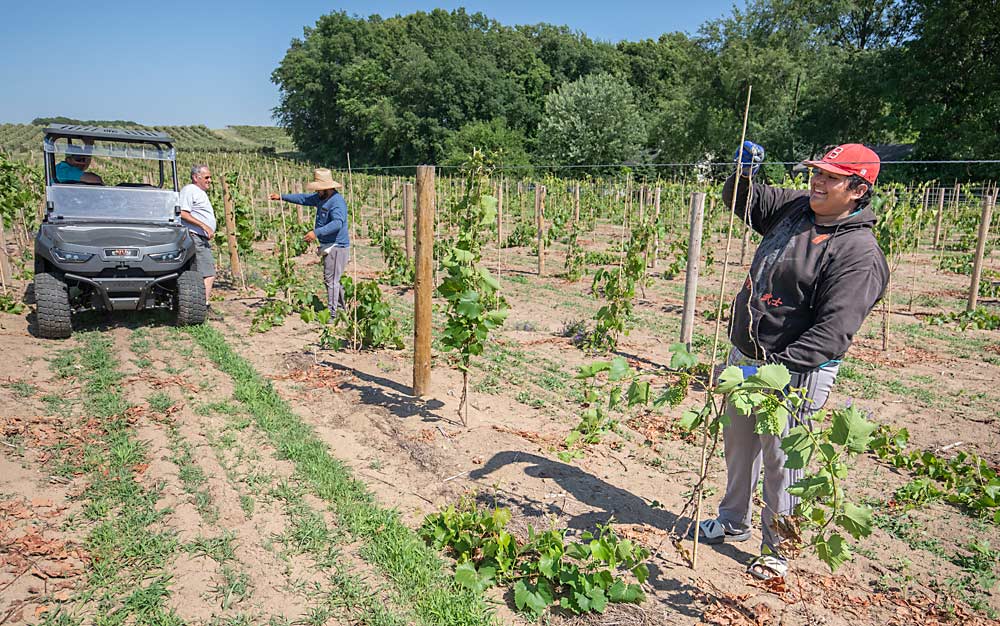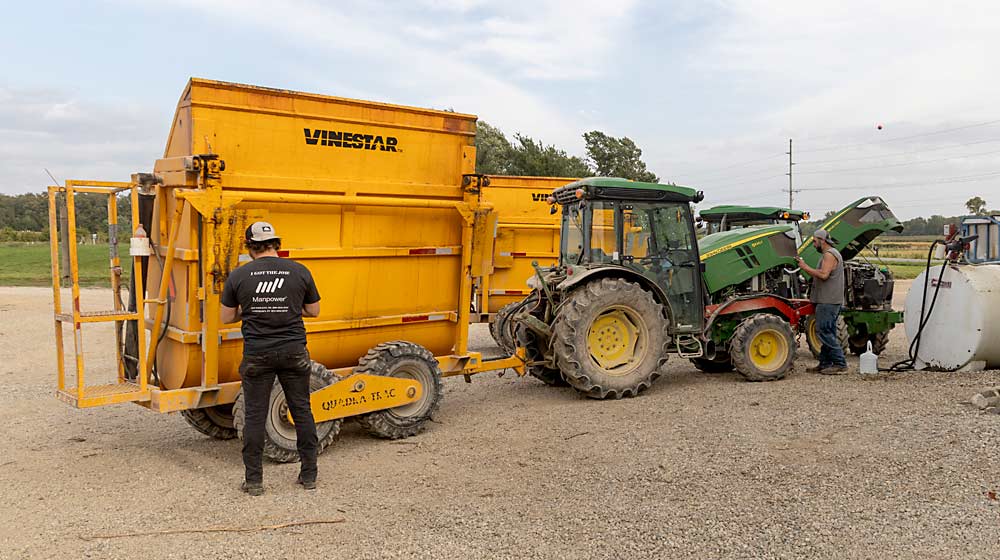[ad_1]
—story and photograph by Matt Milkovich
—photograph by TJ Mullinax

A few many years in the past, a wave of mechanization rolled by means of the Michigan grape business, when juice-grape growers and bigger wine-grape growers began adopting new harvest and different applied sciences.
As soon as that preliminary wave ran its course, nonetheless, the business stopped prioritizing additional technological adoption. However with the rising scarcity of employees, rising prices and ubiquity of labor-saving applied sciences, Michigan State College Extension viticulture specialist Mike Reinke thinks the Michigan grape business is primed for an additional wave of mechanization.
In the meantime, some bigger winery operations have responded to labor shortages by hiring H-2A employees. Whereas the federal guest-worker program can present a dependable pool of expert labor, its wage charges are skyrocketing.
Reinke sees extra hope for labor financial savings in precision cover administration and autonomous applied sciences. These new applied sciences are shifting out of the experimental part in different fruit crops and now have extra agronomic instruments to help them. It’s an excellent alternative for Michigan vineyards to “skip a technology or two” of know-how adoption, he stated.
And with newer mechanical harvesters being gentler than older fashions had been on grapes, many wine grape areas around the globe are abandoning the “romantic notion” that wine varietals have to be harvested by hand. Michigan growers want to contemplate taking the identical step, Reinke stated.
In Southwest Michigan, the place nearly all of the state’s 10,000 acres of juice grapes and three,500 acres of wine grapes are grown, vineyardists had entry to a steady, native workforce for many years. However that labor pool is shrinking.
The business is at a “breaking level” now, with some growers turning to H-2A and others turning to mechanization, grower Chris Oxley stated.
The Oxley household grows 550 acres of juice grapes and 150 acres of wine grapes, all machine harvested. They had been a part of the preliminary wave of mechanization in Michigan vineyards. They nonetheless rent native employees, however to avoid wasting on labor they plant solely wine grape varieties they know might be machine harvested. They’ve additionally designed and constructed their very own tractor-mounted pruning machines, Oxley stated.
For Dan Nitz, who grows 350 acres of wine grapes in Southwest Michigan, labor and different enter prices preserve going up and grape costs aren’t maintaining tempo. Mechanization and rising grapes at scale assist preserve his prices down, he stated.
Nitz nonetheless hires as much as 60 employees per yr by means of a labor contractor. They machine harvest most of his grapes, however they hand decide some for wineries that want it. Leaf pulling, vine tucking and hedging is finished mechanically. Thinning is finished by hand.

Northwest Michigan vineyardists are also utilizing mechanization to economize on labor. Shady Lane Cellars in Suttons Bay makes use of a mixture of mechanical and hand labor for cover administration. Machines do the majority of the hedging and pruning, with employees making the ending touches by hand, stated winery supervisor Andy Fles.
The 65-acre property winery nonetheless has a dependable base of native employees who harvest all of the grapes by hand. The employees are getting older, nonetheless, and if they will’t get replaced, Fles would think about machine harvesting sure varieties.
“However we’re not there but,” he stated.
Farther east, on Outdated Mission Peninsula, Jen and Ben Bramer use a mix of mechanization and H-2A employees to handle about 350 acres of wine grapes for about 35 vineyards.
When the native workforce began drying up greater than a decade in the past, the Bramers constructed and purchased equipment to make up for the shortfall.
“We mechanized as a lot as we are able to, wanting shopping for a harvester, however that’s coming quickly,” Jen stated.
Most of their vineyard prospects, feeling their very own monetary strains, at the moment are keen to just accept mechanically harvested grapes, she stated.
The Bramers began hiring H-2A employees in 2018, which “completely modified our enterprise,” Jen stated. “We now have labor now that can keep the entire season.”
However H-2A is a “double-edged sword,” she stated.
“H-2A has doubled our labor prices,” Jen stated. “I’m not saying the employees aren’t definitely worth the wage, however the will increase aren’t sustainable.” •
[ad_2]

